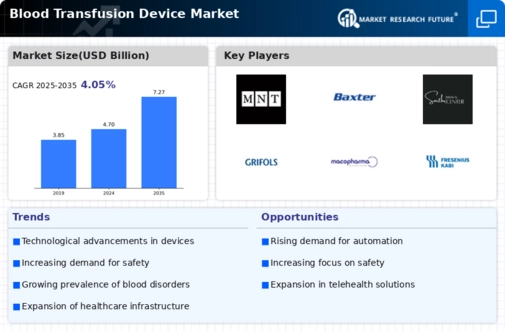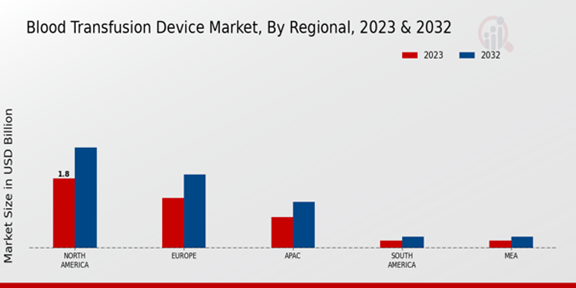Market Growth Projections
Regulatory Support and Standards
Regulatory frameworks and standards established by health authorities significantly influence the Global Blood Transfusion Device Market Industry. Governments and international organizations are increasingly focusing on ensuring the safety and efficacy of blood transfusion devices through stringent regulations. This regulatory support fosters innovation and encourages manufacturers to develop high-quality products that meet safety standards. As compliance with these regulations becomes essential, companies are likely to invest more in research and development, further driving market growth. The anticipated compound annual growth rate of 4.05% from 2025 to 2035 underscores the positive impact of regulatory measures on the industry.
Rising Awareness of Blood Donation
The Global Blood Transfusion Device Market Industry benefits from increasing awareness surrounding blood donation and its critical role in healthcare. Campaigns aimed at educating the public about the importance of donating blood have led to higher donation rates, thereby increasing the availability of blood products for transfusions. This heightened awareness not only supports the operational needs of blood banks but also stimulates demand for advanced transfusion devices that ensure safe handling and storage of blood. As the culture of blood donation continues to grow, the market is poised for sustained expansion, reflecting the interconnectedness of public health initiatives and industry growth.
Increasing Demand for Blood Products
The Global Blood Transfusion Device Market Industry experiences a surge in demand for blood products, driven by rising incidences of chronic diseases and surgical procedures. As healthcare systems worldwide strive to improve patient outcomes, the need for efficient blood transfusion devices becomes paramount. In 2024, the market is projected to reach 4.7 USD Billion, reflecting a growing recognition of the importance of safe and effective blood transfusions. This trend is likely to continue as the global population ages and the prevalence of conditions requiring transfusions increases, thereby propelling the market forward.
Technological Advancements in Blood Transfusion Devices
Technological innovations play a crucial role in shaping the Global Blood Transfusion Device Market Industry. The introduction of automated blood collection systems, advanced blood storage solutions, and real-time monitoring devices enhances the efficiency and safety of blood transfusions. These advancements not only improve patient care but also streamline hospital operations, reducing the risk of transfusion-related complications. As hospitals and blood banks adopt these cutting-edge technologies, the market is expected to grow significantly, with projections indicating a rise to 7.27 USD Billion by 2035, showcasing the transformative impact of technology on blood transfusion practices.
Emerging Markets and Healthcare Infrastructure Development
Emerging markets are witnessing significant improvements in healthcare infrastructure, which is a key driver for the Global Blood Transfusion Device Market Industry. As countries invest in modernizing their healthcare systems, the demand for blood transfusion devices is expected to rise. Enhanced healthcare facilities, coupled with increasing access to medical services, create a favorable environment for the adoption of advanced transfusion technologies. This trend is particularly evident in regions where healthcare access has historically been limited. The growth potential in these markets presents opportunities for manufacturers to expand their reach and contribute to improved healthcare outcomes.




















